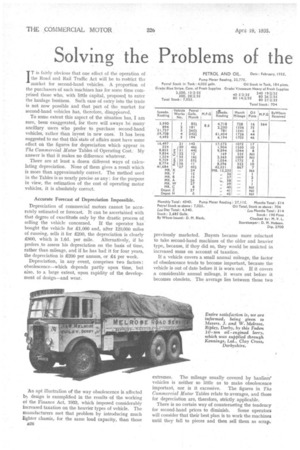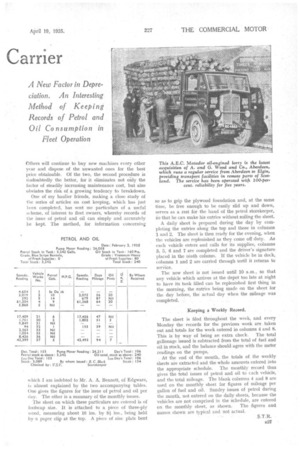Solving the Problems of the
Page 36

Page 37

If you've noticed an error in this article please click here to report it so we can fix it.
Carrier
A New Factor in Depreciation. An Interesting Method of Keeping Records of Petrol and Oil Consumption in Fleet Operation
IT is fairly obvious that one effect of the operation of the Road and Rail Traffic Act will be to restrict the market for second-hand vehicles. A proportion of the purchasers of such machines has for some time comprised those who, with little capital, proposed to enter the haulage business. SuCh ease of entry into the trade is not now possible and that part of the market for second-hand vehicles has, therefore, disappeared.
To some extent this aspect of the situation has, I am sure, been exaggerated, for there will aways be many ancillary users who prefer to purchase second-hand vehicles, rather than invest in new ones. It has been suggested to me that this state of affairs must have some effect on the figures for depreciation which appear in The Commercial Motor Tables of Operating Cost. • My answer is that it makes no difference whatever.
There are at least a dozen different ways of calculating depreciation. None of them gives a result which is more than approximately correct. The method used in the Tables is as nearly precise as any : for the purpose in view, the estimation of the cost of operating motor vehicles, it is absolutely correct.
Accurate Forecast of Depreciation Impossible.
Depreciation of commercial motors cannot be accurately estimated or forecast. It can be ascertained with that degree of exactitude only by the drastic process of .
selling the vehicle concerned. If the operator has bought the vehicle for 21,000 and, after 120,000 miles of running, sells it for 2200, the depreciation is clearly 2800, which is 1,6d. per mile. Alternatively, if he prefers ,to assess his depreciation on the basis of time, rather than mileage, and if he has had it for four years, the depreciation is 2200 per annum, or 24 per week.
Depreciation, in any event, comprises two factors: obsolescence—which depends partly upon time, but also, to a large extent, upon rapidity of the development of design—and wear.
An apt illustration of the way obsolescence is affected la). design is exemplified in the results -of the working of the Finance Act, 1933, which imposed considerably increased taxation on the heavier types of vehicle. The manufacturers met that problem by introducing much lighter chassis,. for the same load capacity, than those
B26. previously marketed. Buyers became more reluctant to take second-hand machines of the older and heavier type, because, if they did so, they would be mulcted in increased sums on account of taxation.
If a vehicle covers a small annual mileage, the factor of obsolescence tends to become important, because the vehicle is out of date before it is worn out. If it covers 0. considerable annual mileage, it wears out before it becomes obsolete. The average lies between those two
extremes. The mileage usually covered by hauliers' vehicles is neither so little as to make obsolescence
important, nor is it excessive. The figures in The Commercial Motor Tables relate to averages, and those for depreciation are, therefore, strictly, applicable.
There is no certain way of counteracting the tendency for second-hand prices to diminish. Some operators will consider that their best plan is to work the machines until they fall to pieces and then sell them as scrap. Others will continue to buy new machines every other year and dispose of the unwanted ones for the best price obtainable. Of the two, the second procedure is Undoubtedly the better, for it eliminates not only the factor of steadily increasing maintenance cost, but also obviates the risk of a growing tendency to breakdown.
One of my haulier friends, making a close study of the series of articles on cost keeping, which has just been completed, has sent me particulars of a useful scheme, of interest to fleet owners, whereby records of the issue of petrol and oil can simply and accurately be kept. The method, for information concerning
which I am indebted to Mr. A. A. Bennett, of Edgware, is almost explained by the two accompanying tables. One gives the figures for the issue of petrol and oil per day. The other is a summary of the monthly issues.
The sheet on which these particulars are entered is of foolscap size. It is attached to a piece of three-ply wood, measuring about 16 ins. by 8i ins., being held by -a paper clip at the top. A piece of zinc plate bent so as to grip the plywood foundation and, at the same time, be free enough to be easily slid up and down, serves as a rest for the hand of the petrol storekeeper. So that he can make his entries without soiling the sheet.
A daily sheet is prepared during the day by completing the entries along the top and those in columns 1 and 2. The sheet is then ready for the evening, when the vehicles are replenished as they come off duty. As each vehicle enters and calls for its supplies, columns 3, 5, 6 and 7 are completed and the driver's signature placed in the ninth column. If the vehicle be in dock, columns 1 and 2 are carried through until it returns to
service.
The new sheet is not issued until 10 a.m., so that
any vehicle which arrives at the depot too late at night to have its tank filled can be replenished first thing in the morning, the entries being made on the sheet for the day before, the actual day when the mileage was completed.
.Keeping a Weekly Record.
The sheet is filed -throughout the week, and every Monday. the records for the previous week are taken out and totals for the week entered in columns 4 and 8.
This is by way of being an extra check. The total gallonage issued is subtracted from the total of fuel and oil in stock, and the balance should agree with the meter readings on the pumps.
At the end of the month, the totals of the weekly
sheets are extracted and the whole amounts entered into
the appropriate schedule. The monthly record thus gives the total issues of petrol and oil to each vehicle,
and the total mileage. The blank columns 4 and 8 are used on the monthly sheet for figures of mileage per
gallon of fuel and oil. Sundry issues of petrol during the month, not entered on the daily sheets, because the vehicles are not comprised in the schedule, are entered
on the monthly sheet, as shown. The figures and
names shown are typical and not actual.




















































































